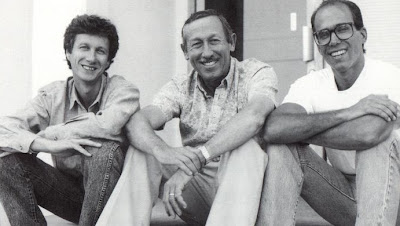 |
| From left to right: Peter Schneider, Roy E. Disney and Jeffrey Katzenberg |
"Waking Sleeping Beauty" is a documentary directed by Disney producer Don Hahn and co-produced with Disney executive Peter Schneider. It focuses primarily the period from the release of "The Fox and the Hound" in 1980 through the release of "The Lion King" in 1994. Disney's animation fortunes began a turnaround starting in 1984 and reached its peak 10 years later.
What makes this documentary so compelling is that most of the major players—Michael Eisner, Jeffrey Katzenberg, Roy E. Disney, Tom Schumacher and Peter Schneider—were interviewed. The one exception is Frank Wells who died in 1994.
Here are some lessons I gleaned from the film:
1. Don Hahn says early in the film that as a kid, he would make a pilgrimage every four years to the theater to see the latest Disney animated masterpiece. I used to do the same. But once these movies started coming out every year in the theaters and several times per year via video, the animated feature film stopped being special. No longer was there a build up of anticipation and excitement for the next Disney feature; it was it had become commonplace.
2. Bringing outsiders into a company can be a good thing. Roy E. Disney brought in Frank Wells to be President and Chief Operating Officer and Michael Eisner to be Chairman and CEO in an attempt to fend off takeovers and the dismantling of the company. Neither man had animation experience but they had been successful executives in their previous positions. Disney wanted to infuse new life and ideas into the company.
Disney later hired Peter Schneider to be the president of the feature film division. He, too, did not have an animation background; he was from the theater. But he knew he couldn't do worse than "The Black Cauldron" and he said, "You can't fall off the first floor." Schneider dissected the entire animation process and questioned everything, knowing he had 100 days to change the culture before it changed him.
3. Bringing outsiders into a company can be a bad thing. Both Katzenberg and Eisner struggled to understand the animation process, like storyboard pitches, since they were accustomed to dealing with scripts. Katzenberg also revealed a lack of understanding of the animation staff when he said he didn't care about the Academy Awards, just the Bank of America awards. It's probably not a good idea to tell a room full of artists-storytellers that the only concern of management is making money.
4. If there's an office, there's politics. When Schneider arrived at the studio, "Oliver & Company" was in production with two directors. Schneider admits that he fired the director who was belligerent towards him and kept the one who sucked up to him. I was struck by Schneider's admission of preference; we're constantly told about the American "meritocracy" in the workplace and how to be worthy of it. So much for that idea!
5. "Nobody knows nothing!" That's a quote from Schneider in reference to Katzenberg thinking "Pocahontas" was going to be a huge hit while having no faith in "The Lion King." There you have it.
6. Ego destroys. There was a continuous power play among Eisner, Katzenberg and Disney regarding credit. I know how important this issue is: I worked as a production assistant for an animator who was obsessed with getting credit because it was denied him by a previous employer. So what did this particular guy do to me and the other production assistant? Had our names removed from a project so he could get credit for…a rabbit voice. Seriously. It wasn't sufficient that he was credited as the production company, producer and maybe even the director. No, he needed credit for making a weird squawking voice over the need to give his staff credit. I learned a lot about how not to treat people from that dude.
But back to Eisner, Katzenberg and Disney—Katzenberg was the media's front man during this peak period and of course, they gave him all of the credit which especially irritated Disney. Wells was the humble one—he kept a piece of paper in his wallet that said "humility is the ultimate virtue"—who balanced the increasingly hostile egos of Eisner, Katzenberg and Disney. Once he died, the balance was completely lost and was never to be regained.
7. Never lobby for a recently deceased guy's job. Katzenberg alleged lobbied hard for Wells job after his untimely death in a helicopter crash. Eisner told Katzenberg that he had originally considered him for the job but had changed his mind. Katzenberg felt he no longer had a future at the company and resigned soon after "The Lion King's" opening. Eisner says in the film that Katzenberg "was a very good executive who just played it wrong. If he'd been happy to stay at the studio, stay at his job, not push everyone against a wall at a moment when someone died, he would've gotten the job if he'd just have the patience to wait." In other words, don't be a pest.
8. What matters most is the work. As Don Hahn says at the end, no one will remember who did what to whom (well, I don't know about that. I still remember who did what to me!) but they will remember the films.
I, for one, hope to have my work remembered fondly like that.
